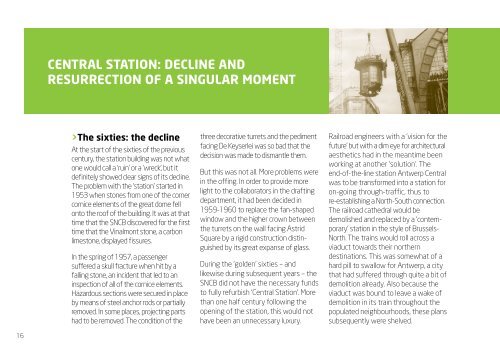Welcome to AntWerp centrAl - Plant Location Europe - home
Welcome to AntWerp centrAl - Plant Location Europe - home
Welcome to AntWerp centrAl - Plant Location Europe - home
Create successful ePaper yourself
Turn your PDF publications into a flip-book with our unique Google optimized e-Paper software.
16<br />
<strong>centrAl</strong> stAtion: decline And<br />
resurrection of A singulAr moment<br />
>the sixties: the decline<br />
At the start of the sixties of the previous<br />
century, the station building was not what<br />
one would call a ‘ruin’ or a ‘wreck’, but it<br />
definitely showed clear signs of its decline.<br />
The problem with the ‘station’ started in<br />
1953 when s<strong>to</strong>nes from one of the corner<br />
cornice elements of the great dome fell<br />
on<strong>to</strong> the roof of the building. It was at that<br />
time that the SNCB discovered for the first<br />
time that the Vinalmont s<strong>to</strong>ne, a carbon<br />
limes<strong>to</strong>ne, displayed fissures.<br />
In the spring of 1957, a passenger<br />
suffered a skull fracture when hit by a<br />
falling s<strong>to</strong>ne, an incident that led <strong>to</strong> an<br />
inspection of all of the cornice elements.<br />
Hazardous sections were secured in place<br />
by means of steel anchor rods or partially<br />
removed. In some places, projecting parts<br />
had <strong>to</strong> be removed. The condition of the<br />
three decorative turrets and the pediment<br />
facing De Keyserlei was so bad that the<br />
decision was made <strong>to</strong> dismantle them.<br />
But this was not all. More problems were<br />
in the offing. In order <strong>to</strong> provide more<br />
light <strong>to</strong> the collabora<strong>to</strong>rs in the drafting<br />
department, it had been decided in<br />
1959-1960 <strong>to</strong> replace the fan-shaped<br />
window and the higher crown between<br />
the turrets on the wall facing Astrid<br />
Square by a rigid construction distinguished<br />
by its great expanse of glass.<br />
During the ‘golden’ sixties – and<br />
likewise during subsequent years – the<br />
SNCB did not have the necessary funds<br />
<strong>to</strong> fully refurbish ‘Central Station’. More<br />
than one half century following the<br />
opening of the station, this would not<br />
have been an unnecessary luxury.<br />
Railroad engineers with a ‘vision for the<br />
future’ but with a dim eye for architectural<br />
aesthetics had in the meantime been<br />
working at another ‘solution’. The<br />
end-of-the-line station Antwerp Central<br />
was <strong>to</strong> be transformed in<strong>to</strong> a station for<br />
on-going through-traffic, thus <strong>to</strong><br />
re-establishing a North-South connection.<br />
The railroad cathedral would be<br />
demolished and replaced by a ‘contemporary’<br />
station in the style of Brussels-<br />
North. The trains would roll across a<br />
viaduct <strong>to</strong>wards their northern<br />
destinations. This was somewhat of a<br />
hard pill <strong>to</strong> swallow for Antwerp, a city<br />
that had suffered through quite a bit of<br />
demolition already. Also because the<br />
viaduct was bound <strong>to</strong> leave a wake of<br />
demolition in its train throughout the<br />
populated neighbourhoods, these plans<br />
subsequently were shelved.


